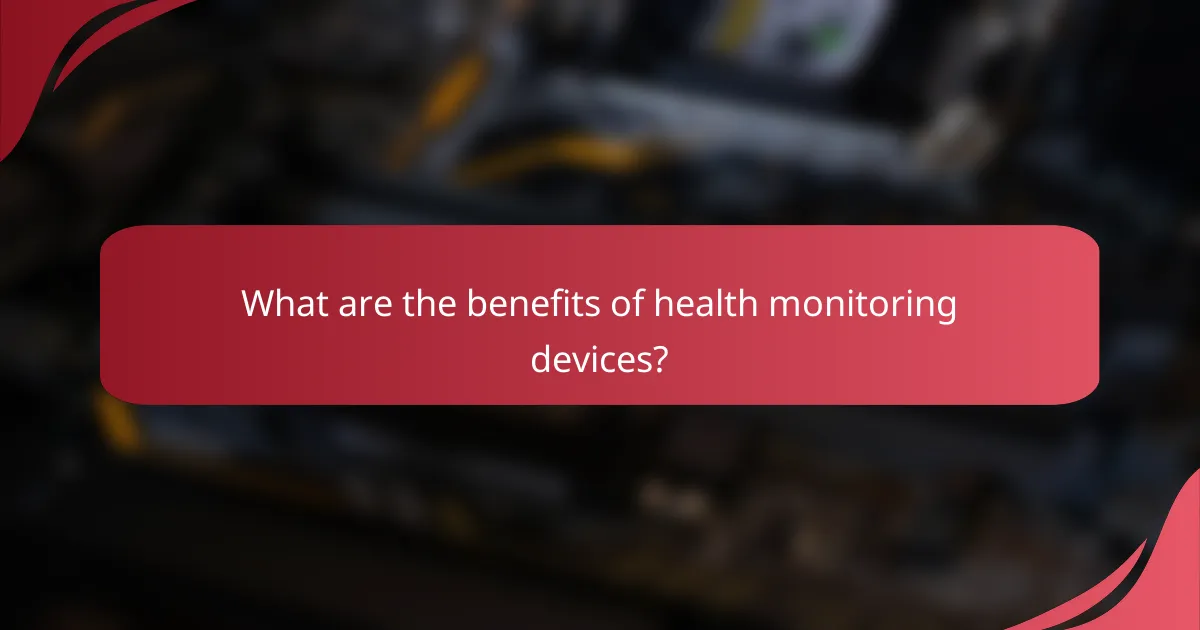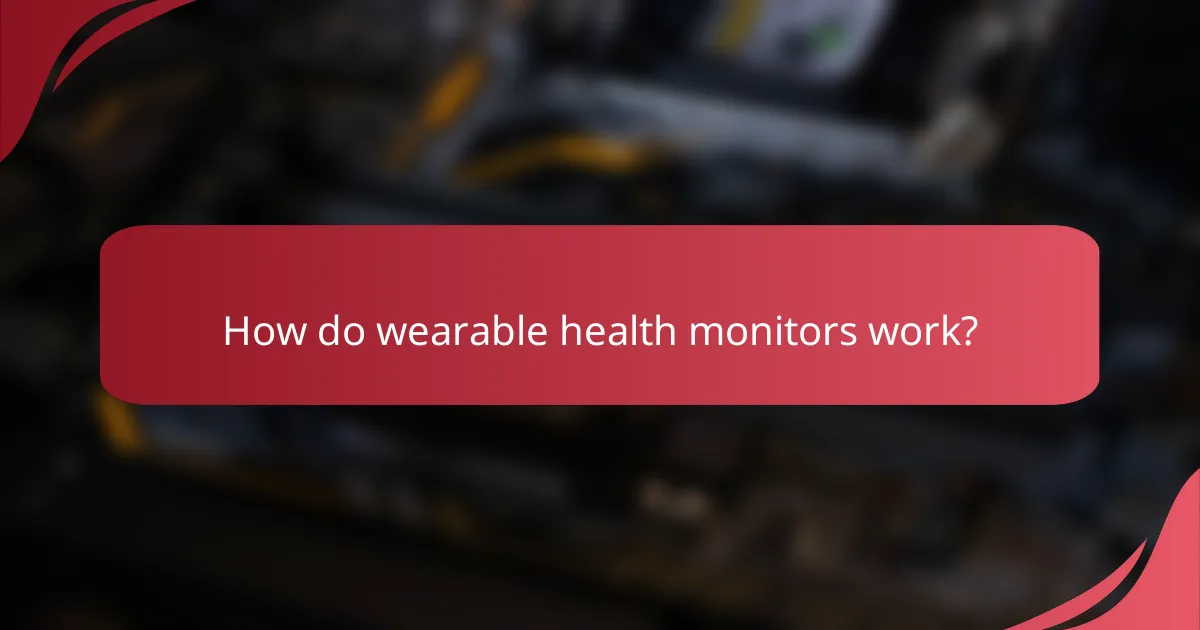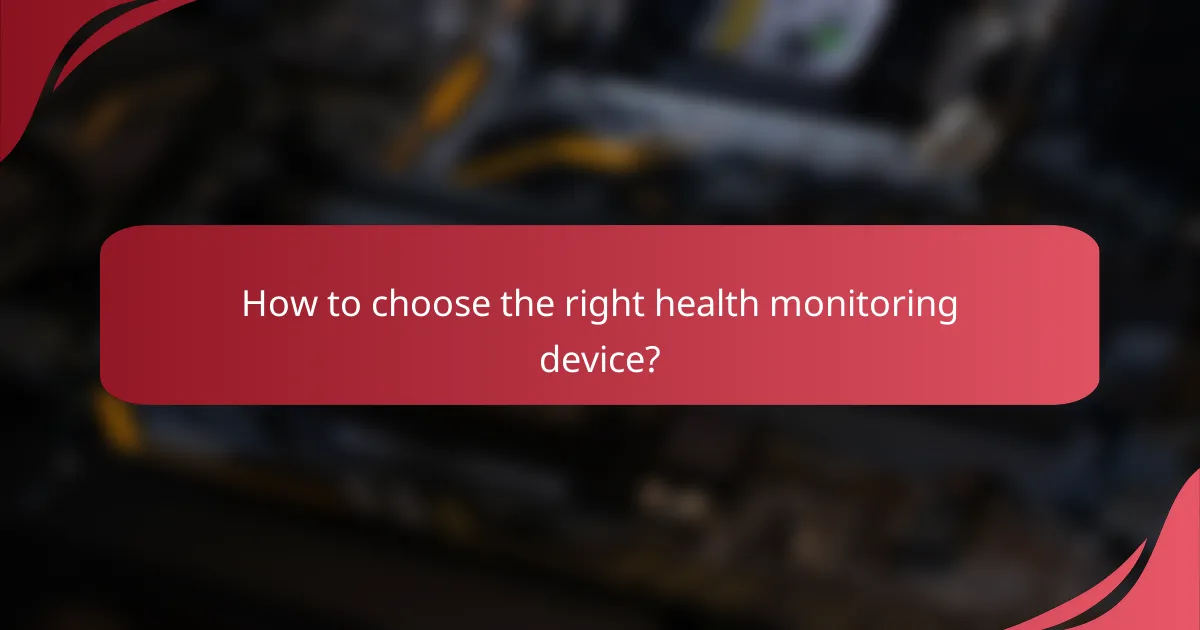Health monitoring is rapidly evolving, offering consumers innovative tools to manage their wellness effectively. With wearable devices that track vital metrics like heart rate and sleep patterns, individuals can gain real-time insights into their health. Emerging trends such as AI-driven analytics and remote monitoring are further enhancing patient care, providing personalized recommendations that empower users to take control of their health journey.

What are the benefits of health monitoring devices?
Health monitoring devices offer numerous advantages, including better management of chronic conditions, enhanced fitness tracking, and immediate health insights. These devices empower consumers to take charge of their health by providing real-time data and fostering greater engagement with their wellness goals.
Improved chronic disease management
Health monitoring devices play a crucial role in managing chronic diseases such as diabetes and hypertension. By continuously tracking vital signs and other health metrics, these devices enable users to make informed decisions about their treatment plans.
For instance, a glucose monitor can alert users when their blood sugar levels are too high or low, prompting timely interventions. This proactive approach can lead to better health outcomes and potentially reduce hospital visits.
Enhanced fitness tracking
Fitness tracking is significantly improved with health monitoring devices, which can record various metrics such as heart rate, steps taken, and calories burned. Users can set personal fitness goals and receive feedback on their progress, making it easier to stay motivated.
Many devices also offer features like workout suggestions and recovery tracking, allowing users to optimize their exercise routines. This data-driven approach can help individuals achieve their fitness objectives more effectively.
Real-time health insights
Real-time health insights are a key benefit of health monitoring devices, providing users with immediate feedback on their physical condition. This information can include heart rate variability, sleep quality, and stress levels, helping users understand their overall health better.
For example, a smartwatch can notify users of irregular heart rhythms, prompting them to seek medical advice if necessary. Access to such insights can lead to early detection of potential health issues.
Increased consumer engagement
Health monitoring devices significantly increase consumer engagement by encouraging individuals to take an active role in their health management. With user-friendly interfaces and mobile app integrations, these devices make tracking health metrics straightforward and accessible.
Moreover, many devices allow for sharing data with healthcare providers, fostering collaborative care. This enhanced communication can lead to more personalized treatment plans and improved health outcomes.

How do wearable health monitors work?
Wearable health monitors function by collecting various physiological data through embedded sensors. These devices track metrics such as heart rate, activity levels, and sleep patterns, providing users with insights into their health and wellness.
Utilization of sensors
Wearable health monitors are equipped with multiple sensors that measure different bodily functions. Common sensors include accelerometers for movement tracking, photoplethysmography (PPG) sensors for heart rate monitoring, and temperature sensors for body temperature assessment.
These sensors work continuously or at set intervals, allowing users to gather real-time data. For example, a fitness tracker may use an accelerometer to count steps throughout the day, providing a comprehensive view of daily activity levels.
Data transmission to mobile apps
Once data is collected, wearable health monitors transmit this information to connected mobile applications via Bluetooth or Wi-Fi. This seamless data transfer enables users to view their health metrics on their smartphones, making it easy to track progress over time.
Mobile apps often provide visual representations of the data, such as graphs and charts, which help users understand trends in their health. For instance, a user can see their heart rate variability over weeks, allowing for better health management.
Integration with health platforms
Many wearable health monitors can integrate with broader health platforms, such as electronic health records (EHR) or fitness ecosystems. This integration allows for a more comprehensive view of an individual’s health by combining data from various sources.
Users can share their data with healthcare providers, enabling personalized health recommendations. Additionally, some platforms offer features like goal setting and reminders, enhancing user engagement and motivation to maintain healthy habits.

What are the emerging trends in health monitoring?
Emerging trends in health monitoring focus on leveraging technology to enhance patient care and improve health outcomes. These trends include AI-driven analytics, remote patient monitoring, and personalized health recommendations, all of which aim to provide more efficient and tailored healthcare solutions.
AI-driven health analytics
AI-driven health analytics utilize machine learning algorithms to analyze vast amounts of health data, identifying patterns and insights that can inform clinical decisions. These tools can predict potential health issues, enabling proactive interventions.
For instance, AI can analyze data from wearable devices to detect irregular heart rhythms or other anomalies, alerting healthcare providers to take timely action. This trend not only enhances diagnostic accuracy but also optimizes treatment plans based on individual patient data.
Remote patient monitoring
Remote patient monitoring (RPM) allows healthcare providers to track patients’ health metrics outside traditional clinical settings, using devices like wearables and mobile apps. This approach is particularly beneficial for managing chronic conditions, as it enables continuous observation and timely adjustments to treatment.
Patients can monitor vital signs such as blood pressure and glucose levels from home, reducing the need for frequent office visits. RPM can lead to improved patient engagement and adherence to treatment plans, ultimately enhancing health outcomes.
Personalized health recommendations
Personalized health recommendations are tailored suggestions based on individual health data, preferences, and lifestyle factors. These recommendations can include dietary advice, exercise plans, and medication adjustments, all aimed at optimizing health for each person.
For example, a health app may analyze a user’s activity levels and dietary habits to provide customized fitness goals or meal plans. This trend empowers individuals to take charge of their health by offering actionable insights that align with their unique circumstances.

Which brands lead the health monitoring market?
Several brands dominate the health monitoring market, with Apple, Fitbit, and Garmin being the most prominent. Each brand offers unique features and capabilities that cater to different consumer needs, making them leaders in this rapidly evolving sector.
Apple Watch
The Apple Watch is renowned for its comprehensive health monitoring features, including heart rate tracking, ECG capabilities, and blood oxygen monitoring. It integrates seamlessly with the iOS ecosystem, allowing users to access health data through the Health app.
One of the standout features is its fitness tracking, which includes various workout modes and activity rings that encourage users to stay active. The device also supports third-party health apps, enhancing its functionality.
When considering the Apple Watch, users should be aware of its price range, typically starting in the low hundreds of USD. Regular software updates ensure that the device remains relevant with new health features.
Fitbit
Fitbit has established itself as a leader in the fitness and health tracking space, offering a range of devices that cater to different lifestyles. Its products focus on step counting, sleep tracking, and heart rate monitoring, making them accessible for casual users.
Fitbit devices often come with a longer battery life compared to smartwatches, lasting several days on a single charge. The Fitbit app provides detailed insights into health metrics, which can motivate users to achieve their fitness goals.
Fitbit’s pricing is generally more affordable than that of the Apple Watch, with many models available under 200 USD. This makes it an attractive option for those looking to start their health monitoring journey without a significant investment.
Garmin
Garmin is well-known for its GPS technology and has successfully integrated this into its health monitoring devices, particularly for outdoor enthusiasts and athletes. Garmin watches offer advanced metrics for running, cycling, and swimming, including VO2 max and recovery time analysis.
The brand’s focus on durability and outdoor functionality makes its devices suitable for a variety of sports and activities. Many Garmin models are water-resistant and designed to withstand tough conditions, appealing to serious athletes.
Garmin products typically range from mid to high hundreds of USD, depending on the features. Users should consider their specific sport and health tracking needs when selecting a Garmin device to ensure they choose the right model for their activities.

How to choose the right health monitoring device?
Choosing the right health monitoring device involves assessing compatibility with your existing technology, evaluating essential features, and considering user feedback. Prioritize devices that align with your health goals and fit seamlessly into your lifestyle.
Consider compatibility with existing devices
When selecting a health monitoring device, ensure it integrates well with your current devices, such as smartphones or smartwatches. Compatibility with popular platforms like iOS or Android can enhance functionality and user experience.
Check if the device syncs with health apps you already use, as this can streamline data tracking. For instance, a blood pressure monitor that connects to your smartphone app can provide real-time insights and historical data analysis.
Evaluate features and functionalities
Assess the features that matter most for your health monitoring needs. Common functionalities include heart rate tracking, sleep analysis, and activity logging. Determine which features align with your health objectives, such as weight management or fitness improvement.
Consider additional functionalities like GPS tracking for outdoor activities or alerts for irregular health patterns. A device with a longer battery life and water resistance may also be beneficial for active users.
Assess user reviews and ratings
User reviews and ratings provide valuable insights into a device’s performance and reliability. Look for feedback on accuracy, ease of use, and customer support. Devices with high ratings and positive reviews often indicate better user satisfaction.
Pay attention to common complaints or issues mentioned by users, as these can highlight potential drawbacks. Websites and forums dedicated to health technology can be excellent resources for gathering diverse opinions and experiences.


